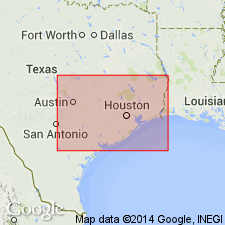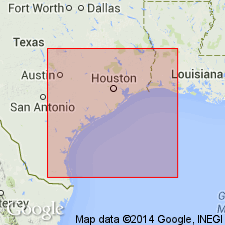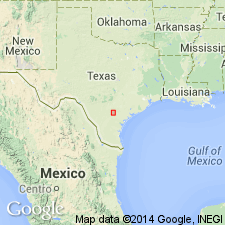
- Usage in publication:
-
- Stone's Switch sand
- Modifications:
-
- Original reference
- Dominant lithology:
-
- Sandstone
- AAPG geologic province:
-
- Gulf Coast basin
Summary:
Pg. 1302, 1314, etc. Stone's Switch sand. Massive indurated quartzitic sandstone, 12 to 20 feet thick, in Whitsett formation as here defined. Name suggested by Sam Houston, who has traced it from King's Hills, McMullen County, to eastern part of Gonzales County, where it is covered by overlap of Catahoula formation. Is quarried about 3 miles south of Campbellton, on J. Bowers survey. A railroad switch at this quarry was named Stone's Switch. Lies stratigraphically above Falls City shale and below Dubose sands and clays, all zones in Whitsett formation.
Source: US geologic names lexicon (USGS Bull. 896, p. 2070).

- Usage in publication:
-
- Stones Switch sandstone member*
- Modifications:
-
- Revised
- Adopted
- AAPG geologic province:
-
- Gulf Coast basin
Summary:
Pg. 2624 (fig. 1), 2626 (table 1), 2632. Stones Switch sandstone member of Whitsett formation. Basal member of Whitsett as defined in this paper. Underlies Dubose member; overlies Conquista clay member (new) of McElroy formation (redefined). Chiefly cross-bedded sandstone containing borings of marine crustacean(?) HALYMENITES MAJOR and, locally, marine or brackish-water fossils, as well as thin lenses of carbonaceous shale and bentonitic clay. Uppermost bed is generally an indurated plant-root-bearing sandstone, or, in some places, an oyster shell bank. Note on derivation of name. Age is late Eocene.
Source: US geologic names lexicon (USGS Bull. 1200, p. 3736-3737)

- Usage in publication:
-
- Stones Switch sandstone member†
- Modifications:
-
- Abandoned
- AAPG geologic province:
-
- Gulf Coast basin
Summary:
†Stones Switch Sandstone Member of Whitsett Formation of Jackson Group abandoned. Its rocks now included in Deweesville Sandstone Member (new) of Whitsett Formation of Jackson Group. [See Eargle (1972) entry under Deweesville.]
Source: Changes in stratigraphic nomenclature, 1972 (USGS Bull. 1394-A, p. A46-A47).
For more information, please contact Nancy Stamm, Geologic Names Committee Secretary.
Asterisk (*) indicates published by U.S. Geological Survey authors.
"No current usage" (†) implies that a name has been abandoned or has fallen into disuse. Former usage and, if known, replacement name given in parentheses ( ).
Slash (/) indicates name conflicts with nomenclatural guidelines (CSN, 1933; ACSN, 1961, 1970; NACSN, 1983, 2005, 2021). May be explained within brackets ([ ]).

